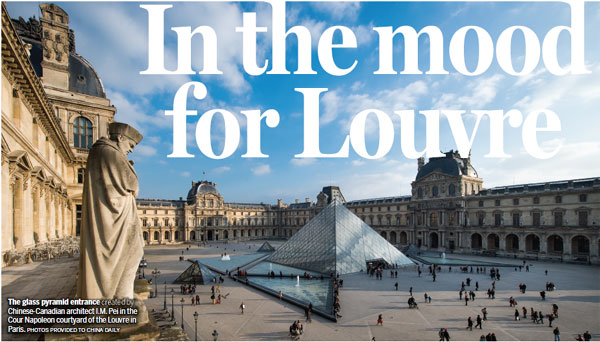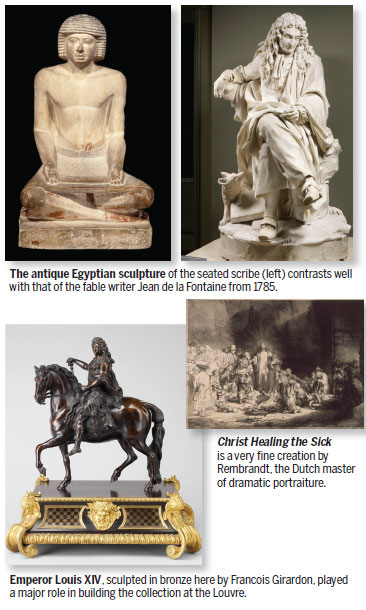In the mood for Louvre
Updated: 2017-04-21 08:50
By Chitralekha Basu(HK Edition)
|
|||||||
A meticulously selected bunch of exhibits from the world's most-visited museum in Paris arrives in HK next week. Chitralekha Basu reports.
In 2016 the visitor turnout to the Louvre dropped by 15 percent. Then 7.3 million is not too bad a figure.
Back in 1682 when Emperor Louis XIV moved out of the Louvre Palace, turning his former residence into a repository of the royal collection of priceless paintings, sculptures and art objects, he probably did not envisage a day when the Louvre would become the world's most-visited museum. And neither did the architects of the French Revolution who had decided that egalitarian principles should extend to the consumption of art as well as that of bread and hence decided to open public access to the royal collection, liberating the likes of the decapitated winged goddess Nike of Samothrace from the exclusive viewership by an elite audience. At that point it was difficult to imagine that one day, just as visitors from the world over would congregate at the Louvre, the museum, on its part, would make a sustained and concerted effort to reach out to the world.
But then the Louvre had its gaze turned on the wide world outside the palace gates all along. The French collectors of the royal court had eclectic tastes, often looking outside their native territory and picking up art objects from across cultures, including highly-valued pieces from antiquity.
For the museum's fans from across the world unable to head off to Paris just yet, the Louvre sometimes brings a meticulously selected bunch of exhibits from its collection over to nearer where they are. Beginning April 26, Hong Kong is going to be the lucky recipient of the Louvre's global outreach program. Hundred and thirty exhibits may not sound like an astounding figure, given the Louvre contains more than 38,000 works of art. However, between them these treasures that go on show at Hong Kong Heritage Museum for the next three months are a narration in the history of the respect and patronage extended to art in France since the 12th century.
The upcoming show in Hong Kong, says co-curator Neguine Mathieux, is the Louvre's largest and most diverse in Asia yet. This has been made possible primarily because of the sound logistical support offered by the Hong Kong Heritage Museum, she adds. "The idea is to present the universality and diversity of the collection housed in the Louvre," says Mathieux. "At the same time we wanted to show something that resonates with this part of the world. We tried to bring paintings, sculptures, artifacts, from the very small to some rather enormous ones. For example, we have some huge tapestries measuring 5 and 6 meters."
There is also a rather delightful Chinese connection. And we are not talking of the most obvious one - the Chinese-Canadian architect I.M. Pei, who created the somewhat-controversial glass pyramid entrance to the museum in 1989. Mathieux draws our attention to the relics unearthed to facilitate the construction of the pyramids in the square courtyard, named after Napoleon and flanked by the Richlieu (north) and Denon (south) wings. "So in trying to add a modern touch to it we discovered a bit about the museum's past. During the excavations we unearthed a few houses that used to be around the museum, and in some of these we discovered the famed Chinese blue pottery from the 17th century." Some of these antique fragments of Chinese porcelain will be displayed at the Hong Kong show.
The oldest exhibit is a limestone figure of a seated scribe from ancient Egypt, circa 2500-2350 BC. It makes an interesting companion piece to a 1785 marble sculpture of the fabulist Jean de la Fontaine by Pierre Julien. Studied together, the writer duo exemplifies some of the fundamental differences between Oriental and Occidental sculpting styles, points out Mathieux. "Ancient Egyptian sculptures were built to be viewed from the front, whereas to appreciate the la Fontaine piece you have to walk all around it. Only then would you see the fox from his stories at his feet and the grapefruit tree behind him."
The Dutch masters
Florian Knothe, director of University Museum and Art Gallery, Hong Kong University, particularly recommends the paintings by the Flemish Baroque painters Peter Paul Rubens (The Three Fates and the Triumph of Truth, 1622), Anthony Van Dyck (Saint Sebastian Bound for Martyrdom, 1641) and an etching of Christ healing the sick from 1649 by the Dutch master of dramatic portraiture, Rembrandt van Rijn. They represent "a variety of genres: propaganda, religious and academic topics that together make a good, well-informed, collection", Knothe points out. It is evident that the collection at the Louvre was started by thoroughbred connoisseurs who had an eye for the world's finest. "The genius of the artists represented and their international standing was appreciated at the time and continues to be celebrated today," says Knothe.
Louis XIV himself was a colossal figure among the royal patrons of art. He owned the Mona Lisa.
"Louis XIV had not only followed his predecessors and enlarged the collections, but also (with his finance minister Jean-Baptiste Colbert) invited unprecedented numbers of foreign artists to work in France," says Knothe. "To us here they illustrate an openness and interest in high quality work, no matter whether it was indigenous of foreign. In Hong Kong, where we see a lot of local and international art, it is worth acknowledging that a past collector like Louis XIV achieved fame for collecting across the board and with an interest in quality."
If you are visiting the Inventing le Louvre show at Hong Kong Heritage Museum in the coming months, you might consider stopping by the bronze equestrian statue of Louis XIV imagined as a Roman emperor by the sculptor Francois Girardon. At 39 centimeters the sculpture isn't that tall, but the man who inspired it seemed to have a king-size vision. He genuinely cared for the future of the art he was collecting during his lifetime. .


(HK Edition 04/21/2017 page1)